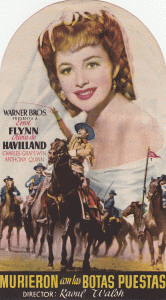Website & blogs © Louis Kraft 2013-2020
Contact Kraft at writerkraft@gmail.com or comment at the end of the blog
I recently heard from a good source that Olivia de Havilland had become frail and spent time in and out of the hospital. But what is frail? … Although I admit that “frail” can be of major importance to all of us, everything is a matter of degrees and all of us are different. As far as hospital visits go, I’ve had 12 operations and I’m still enjoying walking on our earth. Just so everyone knows I’m slow with everything that I write, and this blog is no exception. Sometimes this agitates and angers some of the people that I work with (I’m not talking about my key editors, Chuck Rankin at the University of Oklahoma Press or Greg Lalire at Wild West magazine). Hey, this is just how I am—a slow writer so accept it. Two days ago a friend sent me a link to an interview/article on Ms. de Havilland that went live on January 29 (Entertainment Weekly interviews Olivia de Havilland). This article/interview with Ms. de Havilland left me with the following: She is still active, very positive, and is looking forward to her 100th birthday in 2016.
As Olivia turns 99 years young on July 1, 2015, I want to say some words about this special lady, … this special lady who has kindly shared a small part of her life with me over the years.
Olivia’s Elizabeth Bacon Custer & Errol Flynn’s George Armstrong Custer
As a boy I saw They Died with Their Boots On (Warner Bros., 1941), wherein she played Elizabeth Bacon Custer (“Libbie,” and this is the correct spelling of her nickname) and Errol Flynn played George Armstrong Custer. This film, which has been ripped for historical accuracy, grabbed my interest and never let go. Not to this day. It started me reading about Custer and his Libbie: First young reader books, then biographies, and eventually primary source material in print form or on microfilm. This film all by itself eventually led me to writing and speaking about the American Indian wars.
Olivia, or “Livvie,” became my favorite actress and Flynn became my favorite actor. I will deal with their acting and life and times during their working years together in Errol & Olivia. If you follow me on other social media you know that this book is moving toward becoming my primary writing project. There is a reason for the extended length of time I take to write nonfiction books. Mainly that I must know what I’m going to write about before I write it, and most of the information that I use comes from primary source material. These searches are exhausting, but mandatory for me to complete any nonfiction books.
Livvie and Flynn are still my favorite actors, although there are modern actors that have given performances that have grabbed me and won’t let go no matter how often I study these films. Yes, that’s right, “study.” But also enjoy, and if the “enjoy” fades away it raises the question of why? Why does a film no longer hold up against the test of time? Only a few modern actors—less than twelve—have more than two films that I bother to view more than once or twice.
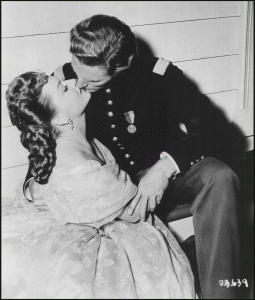
This kissing scene between Olivia de Havilland’s Elizabeth Bacon (before she married GAC) and Errol Flynn’s George Armstrong Custer will be featured in Errol & Olivia (Louis Kraft personal collection)
Back to They Died with Their Boots On, and the lack of historical accuracy. I’m going to say two things about this: 1) Warner Bros. feared lawsuits in 1941, and because of this real participants in the Custers’ lives were dropped from the film and historical events were fictionalized to protect the studio. 2) Go back to the primary source information on Custer (and there is a massive amount available to those who really do research) and also read the three books that Libbie Custer wrote about her time on the frontier during her marriage to George Custer. Match what you find (and trust me, this will take time to find and digest it) and then watch the film again. You will be amazed. I’ve discussed this in print on several occasions and I have spoken about it numerous times.
Enough said, other than to say that They Died with Their Boots On has given us Olivia’s and Flynn’s best performances together. It was also their last, but that only came to be because of future events (which will also be dealt with in Errol & Olivia).
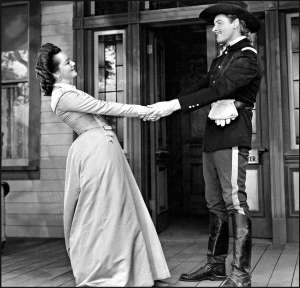
I can’t speak for Bob Utley or Paul Hutton or anyone else who had been influenced by this film (and I know a lot of people that have been), but for me the film grabbed me when Olivia’s Libbie and Flynn’s Custer relocated to the frontier. Actually, it started when Flynn’s Custer stood up to the fictional Senator Sharp and his son Ned Sharp, and when Olivia’s Libbie accepts that they won’t become rich. This image of Olivia and Flynn is on the porch outside their quarters at Fort Lincoln, Dakota Territory, and it easily symbolizes both the real and the fictional General and Mrs. Custer. (Louis Kraft personal collection)
Before moving from Olivia’s Libbie and Flynn’s Custer let me say this. The film not only influenced my future but it has also influenced friends and Indian wars historians Robert M. Utley and Paul Andrew Hutton (among others) big time. Paul Hutton has said in print and to me personally that he fell in love with Olivia the first time he saw her play Libbie Custer, and that this has never changed for him. In his memoir (Custer and Me: A Historian’s Memoir. Norman: University of Oklahoma Press, 2004, page 8), Bob Utley wrote: “Flynn and de Havilland seared themselves into my mind’s eye, planted themselves deeply in my psyche, and treated me repeatedly to the thrilling denouement of the Last Stand.1 … For in 1942, especially in the climate of military celebration created by World War II, I found my obsession.” Livvie and Flynn’s performances led to his long career in the U.S. National Park Service (where I believe Bob retired as chief historian). No matter, for his long list of first-class books dealing with the Indian wars has been inspirational for many historians and would-be historians over the decades.
1 For those of you that don’t know, George Armstrong Custer died during the Battle of the Little Bighorn in Montana Territory on June 25, 1876, when he and his regiment attacked a Lakota, Cheyenne, and Arapaho village. This was the greatest victory of the Plains Indians against the white invasion of their lands, but it also marked the end of their days of freedom for like the defeat of the Alamo in 1836, the attack on Peal Harbor in 1941, and the heinous murder of over 3000 U.S. citizens on September 11, 2001, it would resonate as a rallying cry.
An introduction into Ms. de Havilland’s world
In 1995 my book, Custer and the Cheyenne: George Armstrong Custer’s Winter Campaign on the Southern Plains was published (Upton and Sons, El Segundo, Ca.). That June I spoke about Custer riding into Cheyenne chief and mystic Stone Forehead’s village in the Texas Panhandle to discuss ending war in March 1869 in Amarillo, Texas, which is the subject of the Custer book.
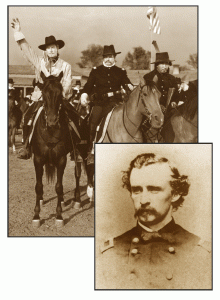
Errol Flynn as George Armstrong Custer and what I consider the quintessential portrait of the real Custer by Matthew Brady and Company in 1864. Flynn’s Custer is about to set out from Fort Abraham Lincoln in Dakota Territory on May 17, 1876, for what would become his final Indian campaign. The real Custer died at the Battle of the Little Bighorn a little over a month later, on June 25. (photos in Louis Kraft personal collection)
During the convention several busses transported us to the Washita River, where Custer’s 7th Cavalry attacked a Cheyenne village, and although many people died, Custer did what he could to prevent the wanton murder of women and children. This site, now the Washita Battlefield National Historic Site, was then on private property. During a stop for lunch, my daughter Marissa and I ate with an historian/professor named Eric Niderost. Just an introduction, but Eric followed up and our brief time together would lead to a long-time friendship that thrives to this day.
In 1995 I decided to write a book about Errol Flynn. Eric knew this. He also had Olivia de Havilland’s address in Paris, France, which has been her home since the 1950s, and in 1996 asked if I’d like to have it. Would I! That year I began writing Ms. de Havilland letters of introduction with absolutely no response. After three or four letters, and many months (a year?) passed I realized that I wasn’t proceeding in a good way.
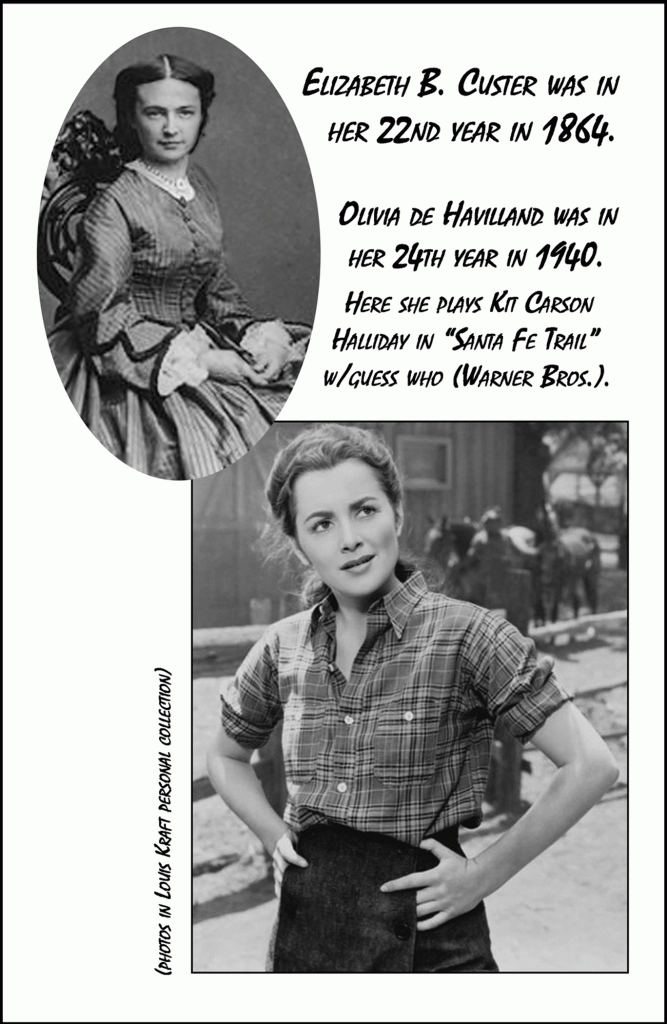 I decided to turn on my charm (I know, I know, since when has Kraft had charm?), and I began sending the lady birthday cards and Christmas cards and gifts. Time passed, but eventually my “charm” and long-distance wooing wore the lady down and she responded. Without going back to check I believe she may have answered a question or two. The correspondence continued into the new century, but I must say that Olivia cherry-picked the questions she would answer. The others she flat-out ignored. I am a gentleman and I never brought up the subject of sex and or love. She would do this for me and in so doing shot holes through bullshit books that create fiction and sell it as fact (sorry, but this is for Errol & Olivia).
I decided to turn on my charm (I know, I know, since when has Kraft had charm?), and I began sending the lady birthday cards and Christmas cards and gifts. Time passed, but eventually my “charm” and long-distance wooing wore the lady down and she responded. Without going back to check I believe she may have answered a question or two. The correspondence continued into the new century, but I must say that Olivia cherry-picked the questions she would answer. The others she flat-out ignored. I am a gentleman and I never brought up the subject of sex and or love. She would do this for me and in so doing shot holes through bullshit books that create fiction and sell it as fact (sorry, but this is for Errol & Olivia).
Sometime in the late 1990s I agreed to write an article for Persimmon Hill that dealt with They Died with Their Boots On, and questions became specific to this film. From this time forward I would read, and eventually listen to and see, Ms. de Havilland’s view on events surrounding this film change, for suddenly what I had brought up took hold within her and created a life of its own.
Errol & Olivia becomes reality
During these early years of our communication I realized that like the biography of Lt. Charles Gatewood and his participation in the Apache wars that I had been writing since 1995 needed something else. In Gatewood’s case the book needed the Bedonkohe Apache mystic and war leader Geronimo. The Flynn book needed Olivia de Havilland, and sometime around 2002 Errol & Olivia became reality.
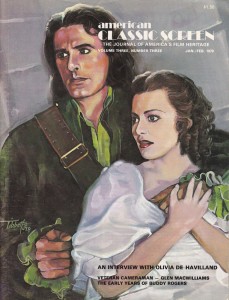
I like the art used on this 1979 American Classic Screen magazine cover. At first I didn’t, but it has grown on me. … I already know what image I want on the cover of Errol & Olivia. Will I or the publisher be able to obtain usage rights? I don’t know. If not, we’ll move to plan B, which isn’t in place at the moment. There is a good possibility that if the original art for this cover can be tracked down that it might be included in plan B, but only if I think that the book title and the author credit won’t hurt the artwork. … I’m sorry, for if you don’t know of Ms. de Havilland and Mr. Flynn’s acting careers, this film, Captain Blood (Warner Bros.-First National Pictures, 1935), made them stars overnight. My favorite scene is the slave auction wherein Olivia’s Arabella Bishop purchases an innocent man, Flynn’s Dr. Peter Blood, who has been convicted of treason in England and shipped to Jamaica where he’ll spend the rest of his life in bondage. Flynn’s Blood would escape and become the most infamous pirate in the Caribbean Sea. Warner Bros. quickly realized that the film-going public fell in love with these young actors and smartly teamed them again and again. Their film relationship has since grown to legendary proportions.
I need to say something here, I take my time with research and a book isn’t completed until I think I have enough information for the book to be published. Olivia de Havilland and Errol Flynn fans have been pounding me for years on when will the book be published. Add to that, Olivia hasn’t been too pleased with my slowness. Let me say this, I began researching and writing a book on Ned Wynkoop in 1985; the book, Ned Wynkoop and the Lonely Road from Sand Creek was published in 2011 (University of Oklahoma Press). I don’t have all the answers on Olivia de Havilland or Errol Flynn for what I need to make Errol & Olivia shine. Until I answer what I consider mandatory questions the book is in the works. That said, Errol & Olivia will be my prime book after Sand Creek and the Tragic End of a Lifeway is published (and for the record I have been researching Sand Creek since 1985). I don’t create history like some unscrupulous writer/historians, who do everything to dupe their readers and create hateful, and sometimes racist nonfiction, that is not accurate or truthful. Some of their words are little more than piss-poor fiction. BTW, this will be an upcoming blog (whenever I have the guts to post it).
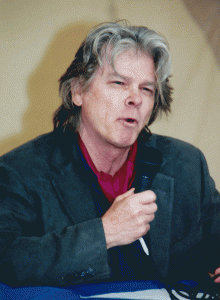
Louis Kraft talking about the Santa Fe Trail (Warner Bros., 1940) film premier in Santa Fe, N. Mex., in the Western Writers of America tent at the Festival of the West in Scottsdale, Ariz., on 19mar2005. When I gave the talk I realized that I had gold—pure gold. Luckily the talk wasn’t taped (actually I hate saying that, for that means it is lost to time). Regarding this talk, which I consider my favorite, I retired it before I drove home. Usually if I like a talk it continues to live. Not this time, for the talk had to be reworked to fit into Errol & Olivia (I realized that it would become a featured piece in the manuscript). (photo by my good friend and great writer Johnny D. Boggs)
Errol & Olivia means a lot to me, and I absolutely refuse to write about something that I can’t confirm. End of story. Everyone who reads my writing knows that patience is key. … For the record I have stopped writing for the software world (since 2012), which means two things: 1) I have turned my back on paydays that would make you sick (read I now count pennies), and 2) I have stopped delivering talks across the U.S. unless I receive my full salary and all expenses (talks cost me a lot of time; their absence has freed up a lot of time for books). I will probably sell a few articles in the coming years, but they (and the photos/artwork) are for pay (which is now needed). My focus are my books. Trust me, and actually bet on the books becoming reality for they will. I work seven days a week, and I don’t have to put in fifty or sixty hours per week plus two+ hours of driving time per day before I go to work on my projects. I now write for me and my reading pubic.
Ladies and gentlemen, sometime in the future that isn’t as distant as you might believe, you will have the opportunity to read Errol & Olivia. Trust me, for the future is closing in on joining hands with reality.
Years passed and my communication with Olivia continued. I realized that to keep our long-distance relationship alive I needed to throw something new into the mix. What? And then it hit me: My daughter Marissa. Believe it or not, this proved to be brilliant on my part.
An invitation by Olivia
In 2002 Olivia invited my daughter Marissa and I to visit her in 2003. I immediately wrote back that we’d love to meet her. No reply, absolutely no reply. In 2003 I realized that I needed an operation If I wanted to continue walking the earth (actually there would be a follow-up operation four and a half months later that played a major role in me actually “walking”). By April 2003 flying to France ceased to be an objective and I forgot about the visit.
But then in fall 2003 Olivia sent me a letter scolding me for not visiting during the previous summer. I quickly replied and we set the date for 2004. As the date neared and with all preparation in place we shared phone numbers. Ms. de Havilland told me that she preferred that I speak with her secretary as her hearing on the phone wasn’t the best, and we set the visit during a 16-day trip to France. At that time Marissa was studying art and her favorites were Claude Monet and Vincent van Gogh. Paris has a wealth of great art museums. We would see them and track van Gogh and Monet.
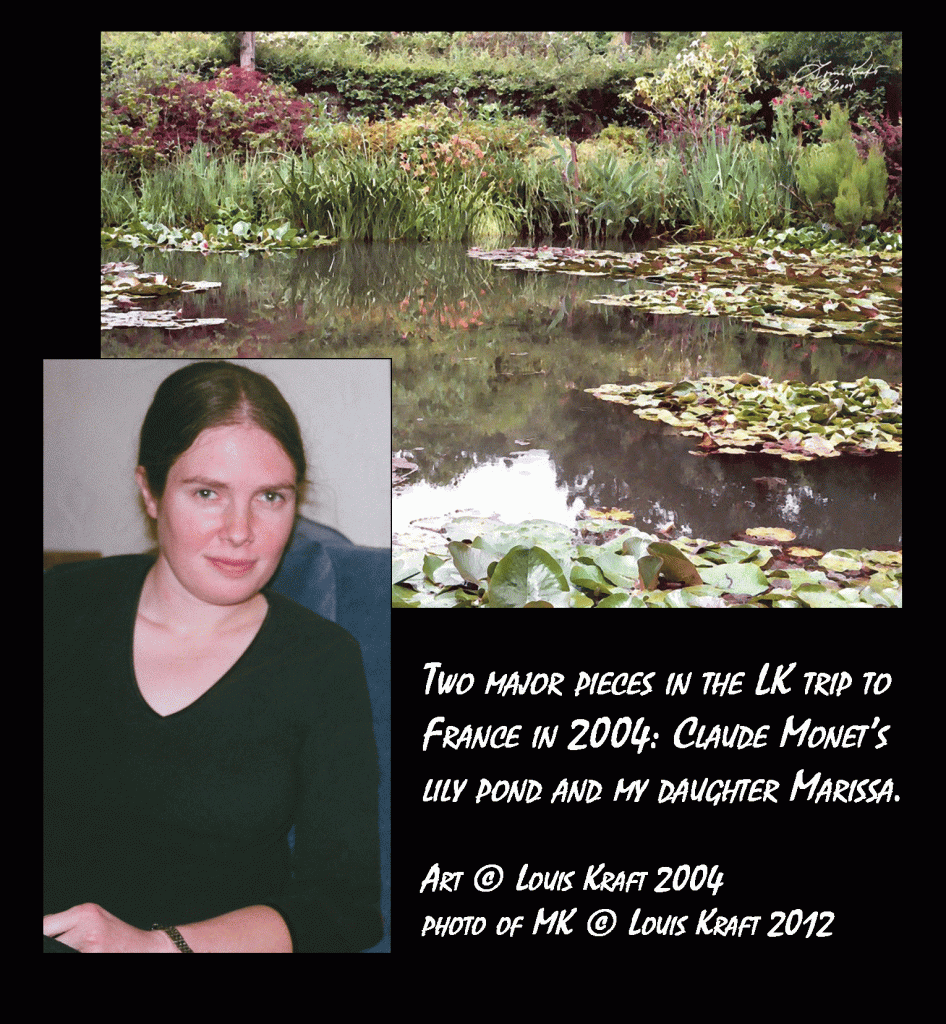 In Olivia’s last communication to me before our flight to France, she wrote: “You are bringing Marissa, aren’t you?” I quickly responded with a short missive. “Yes, ma’am.”
In Olivia’s last communication to me before our flight to France, she wrote: “You are bringing Marissa, aren’t you?” I quickly responded with a short missive. “Yes, ma’am.”
I didn’t know what to expect in France. Heck, I had heard that a lot of the French hate the Americans and that we’d be treated badly. Really? Only once in two prolonged trips to France did I encounter anything like this, and those words were spat at me by an ancient women bent over her cane as we walked past her (can’t remember the name of the town). We’re not going to talk about Paris or France here, but I will say this: I would gladly move to France (even with the hateful crimes that are currently taking the lives of innocent people) as I love Paris and all of the outlying cities and towns that I have visited. Alas, I believe that it is too expensive and my car of choice would hate the French, for they, and certainly in Paris, have a habit of bouncing off the car in front and then the car in the rear when Parisians attempt to parallel park (they perform this process in reverse when exiting the parking spot).
We stayed in a five-star hotel across the street from the French congress named the Meridian, and it was walking distance to Olivia’s home (which is similar to a brownstone in the eastern United States). A day before our visit I walked from the hotel to Olivia’s home as I wanted to take a few photos of it, and more important I wanted to know exactly where it was located. I always enjoy walking in Paris.
A 2004 visit with Olivia de Havilland
(My 35 mm Canon camera went belly up.)
On June 29 the Meridian Hotel called a taxi for Marissa and I. I was loaded down with gifts including flowers, and paper and pens as Olivia didn’t want me to record the interview(s). On this day, Olivia’s then assistant, Laura, joined us in the garden and this made for a nice foursome. Marissa and I sat on each side of Olivia and Laura sat across from her. Fidel, her manservant, served champagne, which Olivia likes.

Marissa took this image of me at Musée Louvre in Paris on July 1, 2004, two days after we visited with Olivia de Havilland. (photo © Louis & Marissa Kraft 2004)
After the introductions we moved to small talk as Olivia looked at and enjoyed her gifts. She does have a lot of my writing from books to plays to articles. I know she’s read some of the material for her comments are such that she had to be familiar with the subject matter. My reason went beyond egotism or anything like this; what I wanted was for her to know that I knew how to create biographies, knew how to research, and could write (it’s shocking that many so-called writers can’t write).
I always go into an interview prepared with questions, and almost always move away from them and go with the flow of where the conversation leads. I prefer this approach as I’m interested learning what I can of the person I’m interviewing and this allows the conversation to move in directions that are of interest to them.
I should say this up front, Olivia is a marvelous hostess. She is open, kind, and attentive. Marissa was fighting perhaps the beginning of a cold and Olivia provided her with medications that could stop what might happen before it did. The pills worked. Olivia also made a point of pulling Marissa into the conversation.
Certainly I did have more questions about her portrayal of Libbie Custer and of the film being the last that she did with Errol Flynn. We spent a long time on this and later that night Olivia returned to it. And clearly her view had begun to change (and even more so than questions she had answered regarding the film years back). What I observed and what has been printed and placed on film is in conflict with the facts. That said, this film was as alive for Olivia de Havilland on that June day in 2004 as it had been for her in 1941. Actually this day appeared to do wonders for the attraction and perhaps love that she and Flynn felt for each other off and on during their working relationship. Alas, events, constantly blocked anything from happening between them. As she later and rightly stated a relationship between them would have ruined her (this is a paraphrase) and I believe this. … All of this said, the love for Errol Flynn that I saw in Olivia de Havilland’s eyes that June 29 was unmistakable.
Fidel positioned himself just inside the house and peeked through the curtains of the French door. When one of us sipped champagne he magically appeared and filled the glass. At one point Olivia asked Marissa why she hadn’t tried the champagne. Shy but not wanting to offend, Marissa lifted the glass to her lips and wet her tongue (and Castro refilled her glass). Although Marissa never said it, Olivia realized that she didn’t drink.
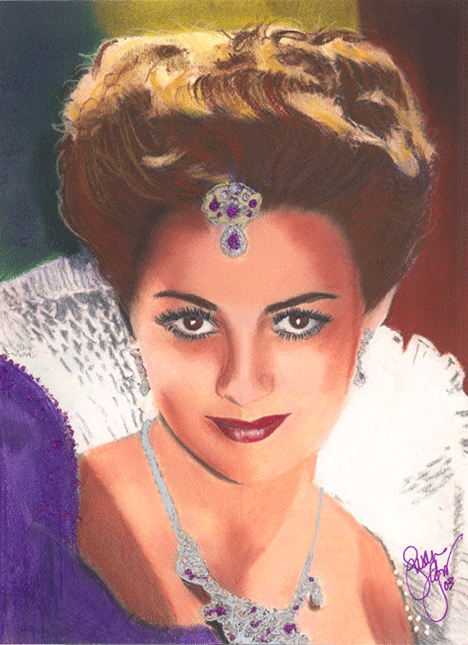
The Private Lives of Elizabeth and Essex is based upon Maxwell Anderson’s 1930 verse play Elizabeth the Queen. The character of Penelope Gray, a fictional character, was also in Anderson’s play. Susan Goulet’s original art of Olivia as Penelope Gray is currently in the Louis Kraft personal collection, but I am considering placing it in the Louis Kraft Collection once Errol & Olivia is published.
One of the gifts I gave Olivia that June 29 was a painting of her as Lady Penelope Gray in The Private Lives of Elizabeth and Essex (Warner Bros., 1939). She knew immediately who she portrayed in the image and was delighted with it. I’m not going to go into details about the film or the difficulties Olivia struggled through during filming other than to say it has a great backstory. I will say this, she was vibrant and alive in her scenes and I think delivered the best performance in the film. Errol & Olivia will deal with the making of this film and Olivia’s and Flynn’s lives at this time. … And with The Adventures of Robin Hood (Warner Bros., 1938), the late thirties set in motion changes to their careers and lives, changes that had actually begun when Captain Blood (Warner Bros.-First National Pictures, 1935) became an instant hit at the box office, changes that would be firmly in place before the end of 1944. These changes would affect the rest of Olivia’s and Flynn’s lives.
Since the late author Charles Higham played high and loose with facts in two books of importance to Olivia, Sisters: The Story of Olivia de Havilland and Joan Fontaine (Coward-McCann, Inc., New York, 1984) and Errol Flynn: The Untold Story (Doubleday & Company, Inc., Garden City, New York,1980) I attempted to get her to comment on stated events (these were included on my list of questions). I had requested information about Higham’s accuracy in the past through the mail and she wrote one comment: “Charles Higham is an unscrupulous man.” Olivia remained firm; she would not talk about Higham or his inflammatory accusations that had no basis in fact. “Charles Higham never contacted me, not once,” Olivia said (this is a paraphrase as the interview is safely stored). My interviews with Olivia will be made available in the Louis Kraft Collection after Errol & Olivia is published.
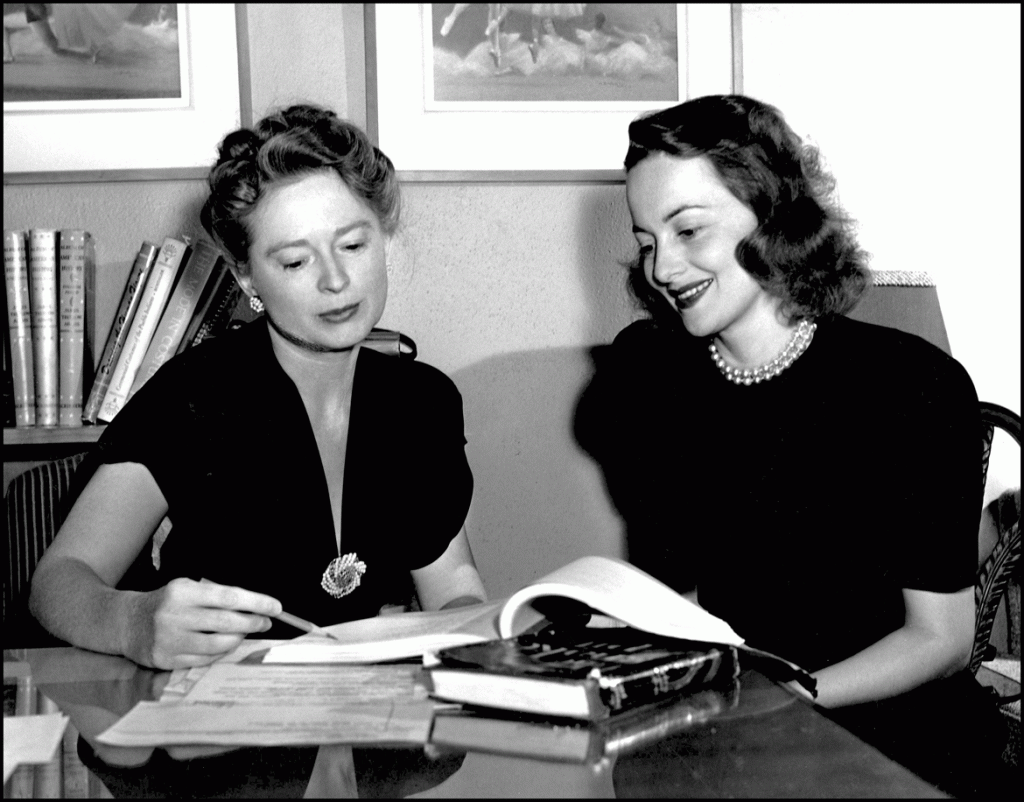
Olivia de Havilland with Mary Jane Ward, author of the semi-autobiographical best selling novel The Snake Pit (New York: Random House, 1946) before principle filming began. It appears that they are looking at a draft of the script for the film. A hardbound copy of The Snake Pit with a battered dust jacket is under the script. (Louis Kraft personal collection)
On more of a positive note, Olivia asked me which of her performances did I like the best. I told her that I thought her best performance was as Virginia Cunningham in The Snake Pit (20th Century Fox, 1948). Her performance is extraordinary as she struggles with fears and doubts that have torn apart her married life and led to her confinement in a mental institution wherein psychiatric care is at times less than humane. Olivia smiled and informed me that it was her favorite role.
Before the evening ended we moved away from Flynn and Olivia’s film world, replacing it with world politics and a little digging into her life. Olivia shied away from her personal life before Hollywood and of her sister, actress Joan Fontaine’s autobiography, No Bed of Roses (William Morrow and Company, Inc., New York, 1978).
At this time of the year it remains light in Paris until about 10:00 PM, and it was close to or just after midnight when Marissa and I hugged Olivia goodbye (and I kissed her on the cheek).
An invitation to Olivia’s big night in 2006
In 2006 I wrote for the now dead company Sun Microsystems. That January my sister, Linda Kraft-Morgon, informed me that she had six weeks left to live. My then manager, Sudeshna Ghosh, did one of the kindest things anyone has ever done for me—she allowed me to come into the office early two to three times per week, drive to Lake Arrowhead to spend two or three hours with my sister, and drive back to the office to work into the night. That gave me four to five days of seeing my sister each week until the end. During the drives up the mountain headaches began to pound. They became so bad that often I had to pull to the side of the road and wait for them to pass and still they affected me once I arrived. I thought that this was just stress.
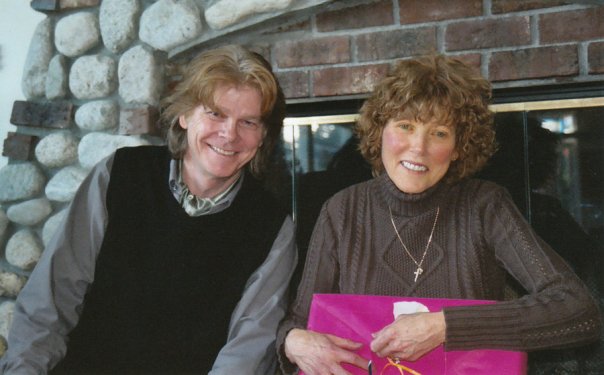
January 15, 2006, was a day that I’ll never forget. Linda and her husband Greg were supposed to come to Tujunga House for Christmas and her birthday (December 24) but I was under the weather and Linda’s immune system could not be put at risk. On this day we celebrated the birth of Christ and her last BD. it was a special day for me. It was also the first day of the few I still had to capture my last memories of her in a handful of stolen hours. (photo © Louis Kraft 2006)
But after my sister’s death on March 1 the headaches didn’t go away; in fact they increased and this included at lower altitudes. … In April I had sinus surgery that included some nasty things and required two weeks recovery with follow-ups with the surgeon.
Just before the surgery I learned that the Academy of Motion Pictures Arts and Sciences in Beverly Hills, California, planned to honor Olivia de Havilland in June. Wonderful news, and long overdue for the two-time Academy Award winner.
| One of her nominations was for The Snake Pit (20th Century Fox, 1948), a film in which she should have won the Oscar as her portrayal as Virginia Cunningham is extraordinary. I have strong views about how award winners are selected and for the most part my views are a little less than laudatory (I hope that the hint of sarcasm shines through here). I was thrilled for her, and that was that for I had no intention of asking for an invitation. |
My then girlfriend and her son took care of me at their home during the two weeks of recovery. When I finally returned home I had a massive amount of emails and phone messages requesting and then demanding invitations to Olivia’s June event. In one particular case a professor and Errol Flynn historian who had become a decent long-distant confidant in all subjects related to Flynn and to a lesser degree Olivia. The messages turned angry and then bitter and sarcastic. I emailed him, saying that I was away and recovering from an operation and that I had no plans to ask for myself or anyone else. “Give me de Havilland’s address and/or phone number!” he demanded. “No!” “Why the bleep not?” “I promised Olivia that I wouldn’t share her private information and I’m not going to share it.” “What about doing this for Deidre Flynn [Flynn’s oldest daughter]; hell, you worked with her?” “I already told you what I’m not going to do.” “You’re no f—ing friend!” “It seems to me that you aren’t either.”
I thought about it and recontacted the professor, who was a good writer and he had certainly done a lot of great research on Flynn. He had one problem; he couldn’t stop polishing his Flynn manuscript that he had told me he had finished writing four or five years before; that is roughly at the time we came in contact with each other. In the email I told him that I would forward Deidre’s information to Olivia if he supplied me with it. He did and I did.
But the relationship had ended. People wonder why I shy away from close relationships with writer/historians who write about the same subjects as I. Well, you’ve just seen one example of why. … Don’t get me wrong, for I’ve got some great writer/historian friends in this small world of Olivia de Havilland and Errol Flynn (David DeWitt and Thomas McNulty to name two) and I certainly have more good friends in my Indian wars world.
Weeks later a surprise arrived in the mail. Olivia had secured an invitation for me to attend her event at the Academy of Motion Picture Arts and Sciences.
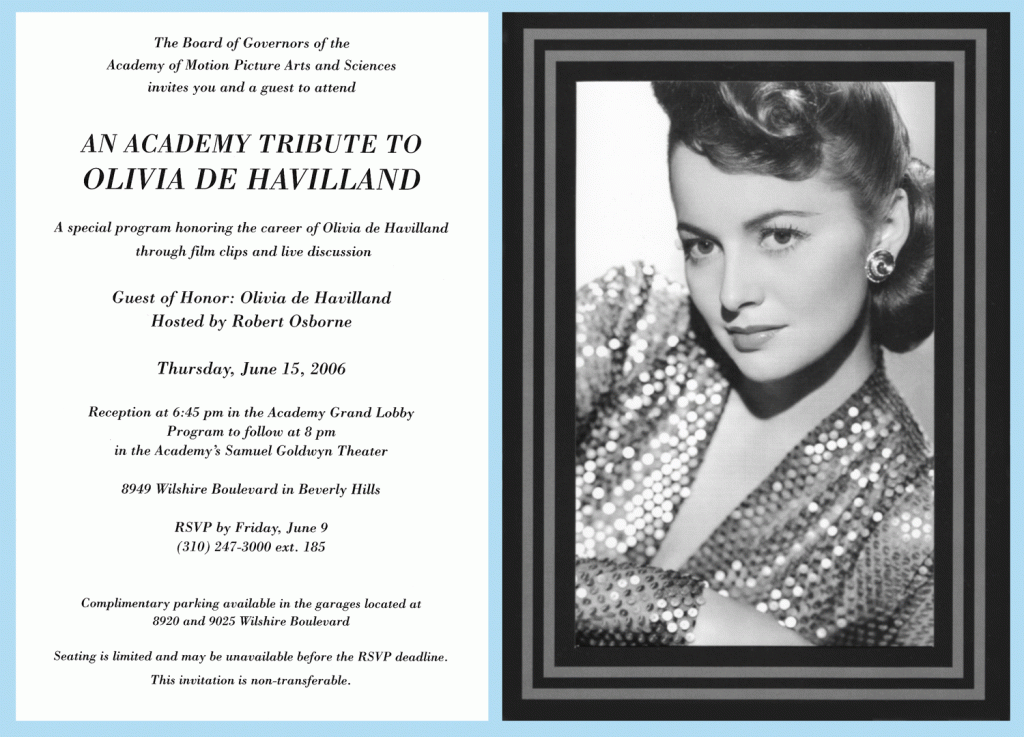
On the left is the invitation to the tribute honoring Olivia de Havilland. On the right is the cover of the invitation (actually the black and gray border opens to reveal a larger image of Livvie). … Ms. de Havilland, thank you again for inviting me to your special night. I enjoyed every minute of the event.
A lady is honored
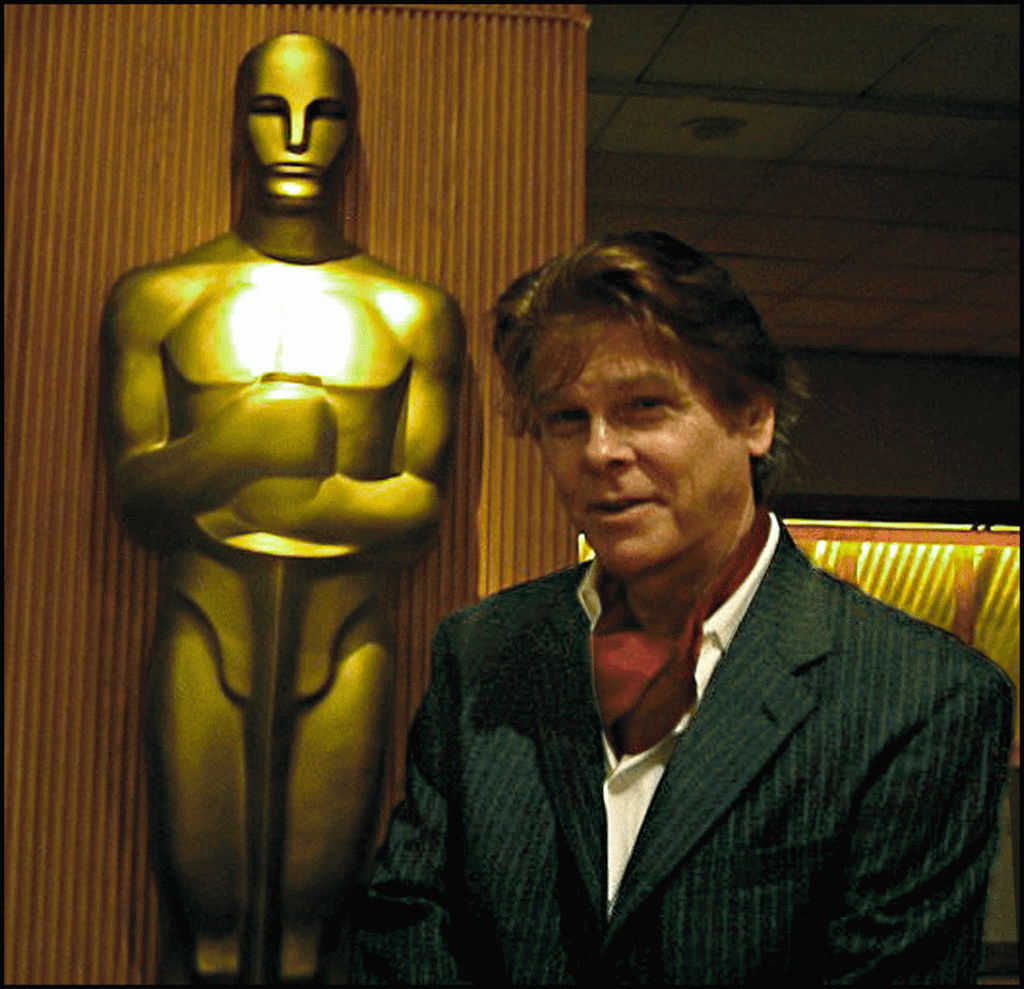
lk soon after entering the main lobby of the Motion Pictures Arts and Sciences building in Beverly Hills on 15jun2006. (photo © Louis Kraft 2006)
On the early evening of June 15, 2006, the sidewalk in front of the Academy of Motion Arts and Sciences on Wilshire Boulevard was crowded with people dressed in gowns and suits, and in one case a tuxedo. While my then girlfriend and I waited I saw the professor/historian in the crowd. Deidre Flynn accompanied him. He looked as he did in pictures that I had seen of him, but I didn’t look as I did on the dust jacket of Lt. Charles Gatewood & His Apache Wars Memoir (University of Nebraska Press, 2005), which he had. The doors opened at a quarter to seven in the evening. Immediately the large lobby bubbled with excitement as the guests mingled and chatted. Caterers brought out platters of absolutely magnificent food. There was an open bar. The Academy had gone all out for Olivia de Havilland’s night of honor.
Diane Moon, my girlfriend, ate with me, but then wandered as she snapped photographs with a cell phone. I drifted about as I enjoyed a glass of wine only to halt. Before me stood Patrice Wymore Flynn. She sipped wine and nibbled. I watched her for a moment, but then stepped forward and began talking with her. After about 10 minutes she looked at me quizzically. “You don’t know who I am,” she said. “Yes I do, Mrs. Flynn.” She liked that and the conversation continued. During the course of the night we spoke several more times. I liked her. Diane caught some candids of our initial meeting.
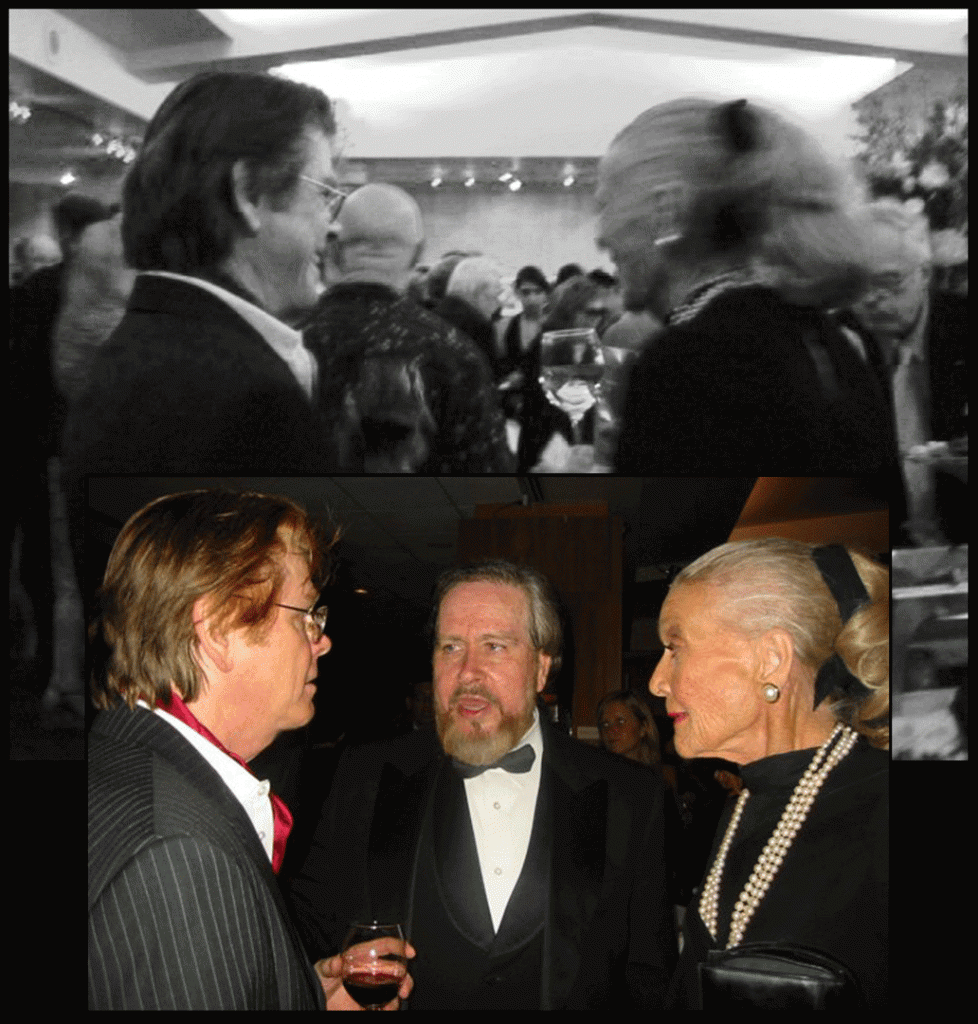
The top of this collage is of Patrice Wymore Flynn and Louis Kraft shortly after we met for the first time. As you can see in the image Pat is moving, and so is LK (but not as quickly). It is actually a color photo, but I thought it would work better here as a grayscale image. Later the professor/historian Lincoln Hurst and I got together. Pat joined us and we had a great roundabout conversation. (photo © Louis Kraft 2006)
For additional thoughts about Patrice Wymore Flynn, see Classy lady Patrice Wymore Flynn dies + a Sand Creek “thank you”.
Later I saw the professor/historian chatting with Robert Osborne, the primary host of Turner Classic Movies. I joined them and introduced myself. Osborne was polite while Lincoln Hurst was taken by surprise. Soon Osborne excused himself and Hurst and I spent a good part of the rest of the evening together. Neither of us mentioned the past April, and it was almost as if we were long-time friends who hadn’t seen each other in a while. I enjoyed hanging out with him. Diane captured some pictures, and then more when Pat Wymore Flynn joined us.
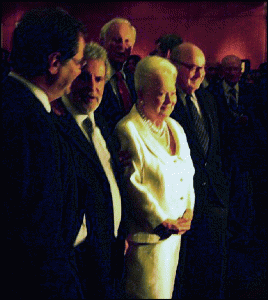
About an hour after the doors opened at the Academy of Motion Picture Arts and Sciences Olivia de Havilland made her entry and greeted the crowd. (image © Louis Kraft 2006)
Olivia arrived with a bunch of gentlemen in suits, none of whom I recognized. Soon after the Academy set her up in a room to greet those she had placed on a list. Diane and I got into the line. When we reached the front of it one of the two wanna-be football players asked for my name. I gave it to him. “You’re not on the list.” “Take another look.” He did. “You’re not of the list.” I spelled my name and he looked again. “You’re not on the list.” Could the SOB read? Trying to control my anger I said: “Look, I don’t know anyone here and the only reason I’m here is because Olivia de Havilland invited me.” “You’re not on the list. Step out of the line!” I peered beyond him and could see Olivia greeting people. “Why don’t you trot over to Ms. de Havilland and ask her if I’m on the list.” Surprisingly he did. “Please accept my apologies, Mr. Kraft,” he said when he returned to me. “You are on the list.”
When it was our turn to be with Olivia, I went down on one knee and kissed her hand as Diane hovered nearby. “She’s gorgeous,” Olivia whispered into my ear, and she was. These minutes passed quickly, so quickly that I can’t remember what we talked about (I wrote notes of the event, so hopefully I jotted information about our brief time together—I need to check).
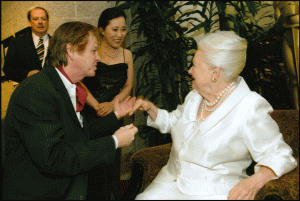
After kissing Olivia de Havilland’s hand I introduced her to my then girlfriend. (photo courtesy of the Academy of Motion Picture Arts and Sciences)
Pat Wymore Flynn and Deidre Flynn had been in front of us in the line and they remained in the room after spending time with Olivia. I joined them. By this time Pat and I had hit it off and enjoyed each other’s company. I had worked with Deidre on a miniseries called Robert Kennedy and His Times back in 1983 or 1984. We had been polite to each other, but at that time she was dealing with a god-awful miniseries about her father (she refused to work for the company) and I gave her room. She had no idea I even knew who her father was. I had heard that her sister, Rory, attended the event but I didn’t see her.
Later Lincoln Hurst, Diane, and I hung out together. An announcement proclaimed that it was time for the event to begin. He excused himself but then soon rejoined us. He couldn’t find Deidre and assumed that she was with Pat. The three of us sat together during the rest of the evening. I had an absolutely terrific time with him. Alas, that was it. I never saw him again, I never had contact with him again, and unfortunately he died a little over two years later. His book on Flynn was never published. This is a shame for I think it would have been a first-class book.
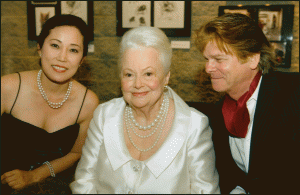
A portrait of Olivia de Havilland, Diane Moon, and Louis Kraft on the evening of 15jun2006. (photo courtesy of the Academy of Motion Picture Arts and Sciences)
Robert Osborne served as host for the event (he may have been Olivia’s choice for she had told me that he was a good friend). Without checking notes (which are in a secure location) I can’t remember if the question and answer portion of the evening was first or the film clips. Regardless of my memory, Olivia walked down the long walkway from the rear of the theater to the stage and sat with Osborne. BTW, the theater was filled. Olivia and Osborne chatted, and I’m certain that the questions came first. Although she obviously got along well with Osborne, the questions had been pre-selected for Olivia did not have to dig into her memory to answer them.
I believe the event was filmed. I hope so, but if yes, I’ve never seen it. I should check.
On this night, or soon after, Olivia gave me an open invitation. “If ever you are again in Paris, let me know so that I can invite you to visit.” These words lived with me for the next two and a half years.
A 2009 visit with Olivia de Havilland
In spring 2009 I contacted Olivia and informed her that I planned a trip to France and England. As she had offered in 2006 she invited me to visit, that we’d agree upon a date once I knew the dates of my time in Paris. Diane Moon accompanied me on this trip to visit Olivia.
Before leaving for Europe a writer contacted me via email and asked if I could put in a good word for him. He had written a coffee table book that dealt with Flynn and others. He explained that he had sent his book to Olivia and hoped to visit her since he was also writing a book about her and Flynn. I had already heard this and agreed to do what I could to help him in a return email.
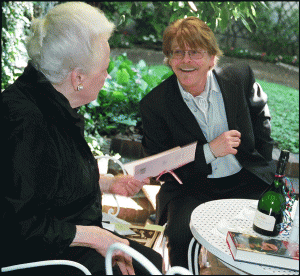
Olivia de Havilland and Louis Kraft chatted while she opened her birthday card and looked at her gifts. That is the champagne bottle on the table but unfortunately we can’t see the label. The book is an anthology called Custer and His Times, Book Five (Cordova, TN: Little Big Horn Associates, Inc., 2008). It contains an article of mine, “Ned Wynkoop’s Lonely Walk Between the Races.” John P. Hart is the editor, and it is an excellent publication. (photo © Louis Kraft 2009)
On July 3 Diane and I arrived at Olivia’s home after a taxi drive across the city of Paris. Her current assistant, Emily, greeted us at the door (Fidel wasn’t present). She would spend some time with us, but also took care of other business including a meal which was similar to my first visit (finger food that was tasty and easy to eat without interrupting Olivia’s and my time together). As it was just two days past her birthday her gifts (other than the usual) included flowers and champagne. The three of us chatted while she delighted in the gifts. Knowing she liked champagne, we brought what we had been told was one of the best American brands. Olivia was thrilled, but I told her not to open it. She agreed and said she’d open it on Errol’s 2010 birthday. I liked her words.
All this time, which probably took half an hour, Olivia had the writer’s book on her lap.2 She wanted to know what I thought of the book. I told her that I thought it was okay for what it was, a coffee table book, while adding that I didn’t see any noticeable errors in it. Olivia then turned to a page that had a not-frequently seen photo of Nora Eddington on it. Nora was Flynn’s second wife (whom Olivia told me that she had never met), and the photo was indeed of Nora. Olivia didn’t think so and we went on about this for five minutes or more. The photo was of Nora and I assured her that the writer wasn’t in error. Finally she accepted this.
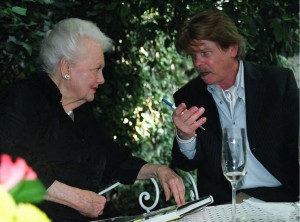
Olivia de Havilland and Louis Kraft discuss the coffee table book that deals with Errol Flynn and others. (photo © Louis Kraft 2009)
“I’m helping you,” she stated. “How can I also help him?” “Simple,” I replied, “help him.” “What about you?” “Help me too.” This seemed beyond her comprehension, although I did encounter this in my dark past.
Twice.
In the early 1970s Patric Knowles, who had acted with Olivia and Flynn in three films, was a patient of my father-in-law. … Patric readily agreed to spend time with me so that I could interview him. Mr. Knowles was as he appeared on screen, a gentleman. We got along fabulously, and kept in contact for years after meeting. However, during the interview he refused to discuss anything associated with Errol Flynn, especially The Adventures of Robin Hood. Frustrated I finally asked why. He had been paid a fee to supply information for a book that was in process.
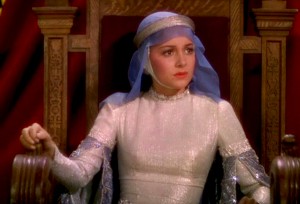
Olivia de Havilland as Maid Marian in The Adventures of Robin Hood. The setting is an archery contest, but it is little more than a trap to capture Robin Hood. These are tense moments for Olivia’s Marian for she has realized that it is a trap. She also knows that Errol Flynn’s Robin Hood is present. If you’ve never seen this film, do yourself a favor and see it. (Louis Kraft personal collection)
I believe that the book was Tony Thomas’s Cads and Cavaliers: The Film Adventurers (A. S. Barnes and Company, South Brunswick and New York, 1973), but I didn’t bother to note the author that Knowles helped. Even though Knowles isn’t recognized in the Acknowledgments of this book I believe that it is the book in question as it deals with him taking Flynn up in his plane during the filming of Robin Hood and this is exactly where I directed my questions. The second time was when I approached my boyhood baseball hero, Duke Snider, to write a book about his life and career. I had already written two or more articles about him which he had seen, but he declined as another writer had beaten me to the punch (Duke Snider and Bill Gilbert, The Duke of Flatbush, Citadel Press Books, New York, 1988).
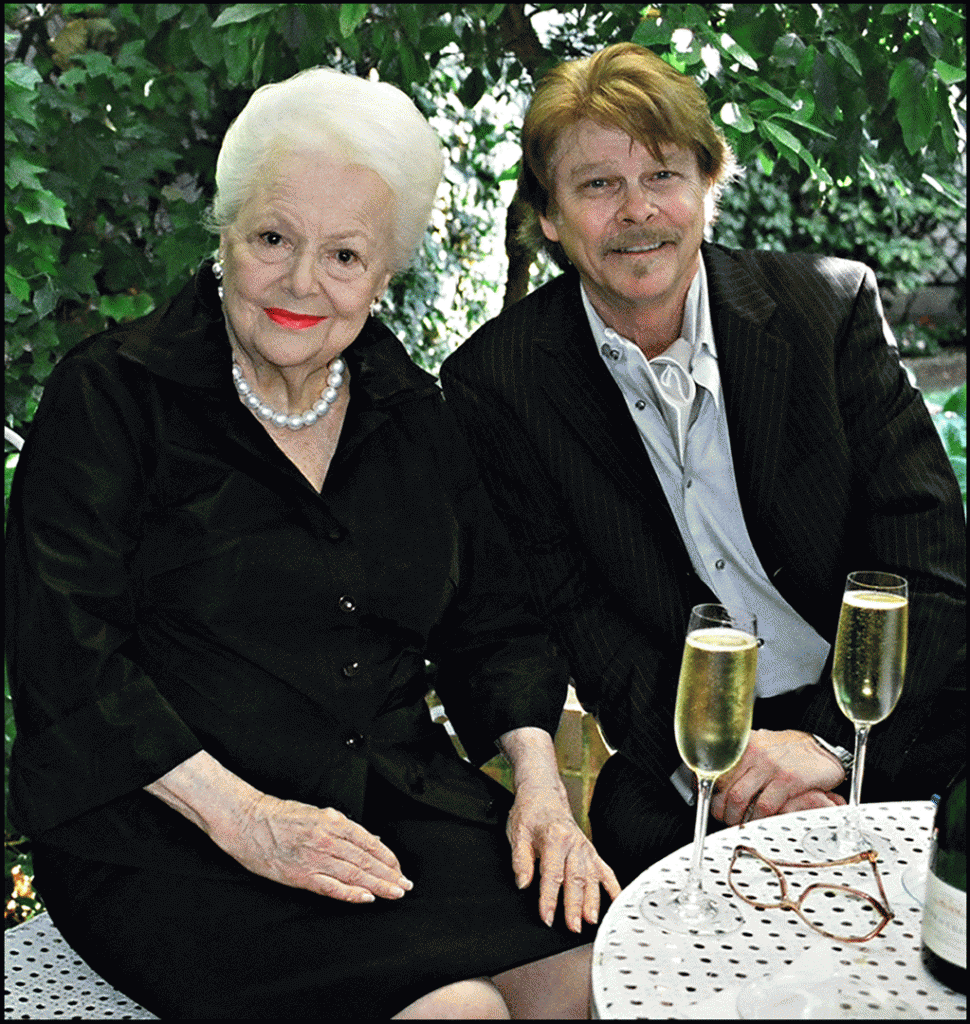
One of the portraits of Olivia de Havilland and Louis Kraft in her garden on 3jul2009. (photo © Louis Kraft 2009)
Back to Olivia, who pressed that she could only help one person. I didn’t agree with this and I still don’t. “Two books are better than one, three books are better than two, and four books are better than three,” I stated. “Why?” “Because it gives readers a choice. They’ll figure out which are good books and which aren’t.”
She accepted this and we moved on.
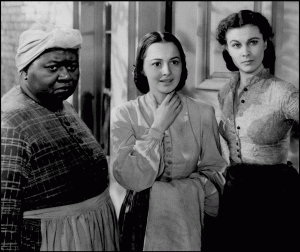
Hattie McDaniel (who won the best supporting actress Academy Award for her portrayal as Mammy), Olivia de Havilland (who was nominated, and rightfully so for her portrayal as Melanie), and Vivien Leigh (who won the Academy Award for best actress as Scarlett O’Hara) in Gone with the Wind. (Louis Kraft personal collection)
On this visit I had an extensive list of questions and there was no way we could deal with all of them. On this trip I wanted to gather information about key people in her life other than Flynn during her time at Warner Bros. She talked some, good stuff, but I don’t have dates on some of it. The search goes on, for I must confirm stories and place them where they belong in time and not a year before or two years after. Ladies and gentlemen, this is time consuming. Trust me, I track all leads. Without going back and checking, it was on this visit that I asked about Olivia being cast as Melanie in Gone with the Wind (Metro-Goldwyn-Mayer, 1939). I’ve read numerous stories about how Olivia landed the role, most likely the most important role she ever played in her career. She told me her story. When I said that it didn’t agree with the other stories she told me that the other stories were wrong.
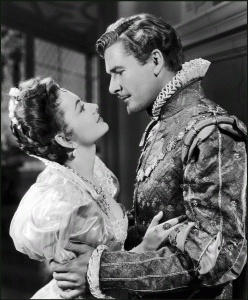
Olivia de Havilland and Errol Flynn as Lady Penelope Gray and Robert Devereaux, the 2nd Earl of Essex in The Private Lives of Elizabeth and Essex (Warner Bros., 1939). The film had a great director who knew how to move plot, Michael Curtiz, and good acting, especially by Olivia, Flynn, and the supporting cast (I will deal with Bette Davis’s performance as Queen Elizabeth I of England in Errol & Olivia). But—always that damned but—but the screenwriters couldn’t free themselves from playwright Maxwell Anderson’s stilted verse/prose in Elizabeth the Queen, producer Hal Wallis also flailed about when usually he had a deadeye for good scripts, and finally Mike Curtiz remained silent. Numerous Academy Award nominations aside, the slow-moving film could have been a glorious adventure/love story turned tragical. What could have been would never be. (Louis Kraft personal collection)
More important, her being cast as Melanie placed her front and center with Jack Warner and Hal Wallis, who, like it or not, were the most powerful people in her aspiring film career. Even though Warners would receive great compensation for her loan-out these men did not like rebels. They handed down punishment to whomever they considered a contractual slave at Warner Bros. Olivia had as much as committed treason. She would be punished, and big time. They also did what they could to humiliate her and here they also succeeded. But she fought back with anger, some good performances, and when her seven-year contract ended she told them goodbye. They said no, that she owed them for the time she spent on suspension (that was time with no salary and no work at the studio). When Olivia refused to buckle and crawl back to them and beg forgiveness they blacklisted her. They sent out a letter that demanded that no film or theater company in the United States hire her. Warner Bros. wielded power, the threat clear, and Olivia de Havilland ceased to earn her living as an actress in the USA (do I dare to say, in “the land of the free”?).
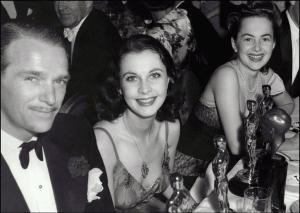
On February 29, 1940, the Academy of Motion Pictures Arts and Sciences held their awards ceremony for the year 1939. Olivia did not win a supporting actress award for her portrayal of Melanie in Gone with the Wind, losing to Hattie McDaniel for her wonderful portrayal as Mammy in the same film. You can’t tell by this photo but the loss hurt—big time. Later, Olivia would say that she was thrilled that Hattie won the award. At the left of the image is Douglas Fairbanks, Jr., who accepted a special award for his father, Douglas Fairbanks, who had died the previous December. In the center is Vivien Leigh, who won an Oscar for her portrayal as Scarlett O’Hara. I’m not certain about the seating during the night’s festivities, but some swapping of seats did happen that night for I have seen several images of Lawrence Oliver sitting to Leigh’s right on this night (Leigh and Oliver married on 31aug1940). I’ve always enjoyed Doug Jr.’s performances (much more so than his father’s), and it is too bad that he never acted with Olivia or Flynn. (Louis Kraft personal collection)
Olivia did not fall to the ground and creep away never to be heard of again. Instead she sued Warner Bros., and in 1944 she won a major decision, since known at the “de Havilland Decision.” Free! She was free to seek acting employment elsewhere. This decision would play a role in the beginning of the end of the studio system as it was in the early 1940s, … and ultimately it contributed to the major freelance film contracts that now earn stars millions of dollars for a film performance. Actors of the last 40+ years (perhaps longer) need to send Olivia de Havilland a letter thanking her for her courage.
Oh, we did spend some time with Mr. Flynn, and for me this was key time, especially with two events in both their lives. One I can date, and the other I can’t although I know the three other key players involved in this star-studded event. Also, she surprised me with her comments about the management heads at Warner Bros., and this was an eye opener.
Diane grew tired and bored. She excused herself and joined Emily in the house while Olivia and I continued to chat and enjoy each other’s company. I didn’t want to leave but realized that the hour now hovered close to midnight. I excused myself, found Emily, and asked her to call a cab. I then returned to Olivia to enjoy my remaining time with her.
2 I have comments regarding what happened with the writer who asked me to pitch him to Olivia. These will appear in another blog (maybe, or maybe not).
Olivia de Havilland, a special lady
I pray God that Olivia’s health remains good. I have just sent her a card stating this, and it is from my heart.
|
Ms. de Havilland, although early I want to wish you a wonderful 2015 birthday |
Olivia de Havilland is a multifaceted person. She is intelligent, beautiful, charming, funny, sexy as hell, political, caring, and courageous. Oh, and I don’t want to forget this: She is a great actress. Ms. Olivia de Havilland, God bless you for all you have done to make the world a brighter place. … I do hope that I can again cross the Atlantic Ocean and spend more time with you.
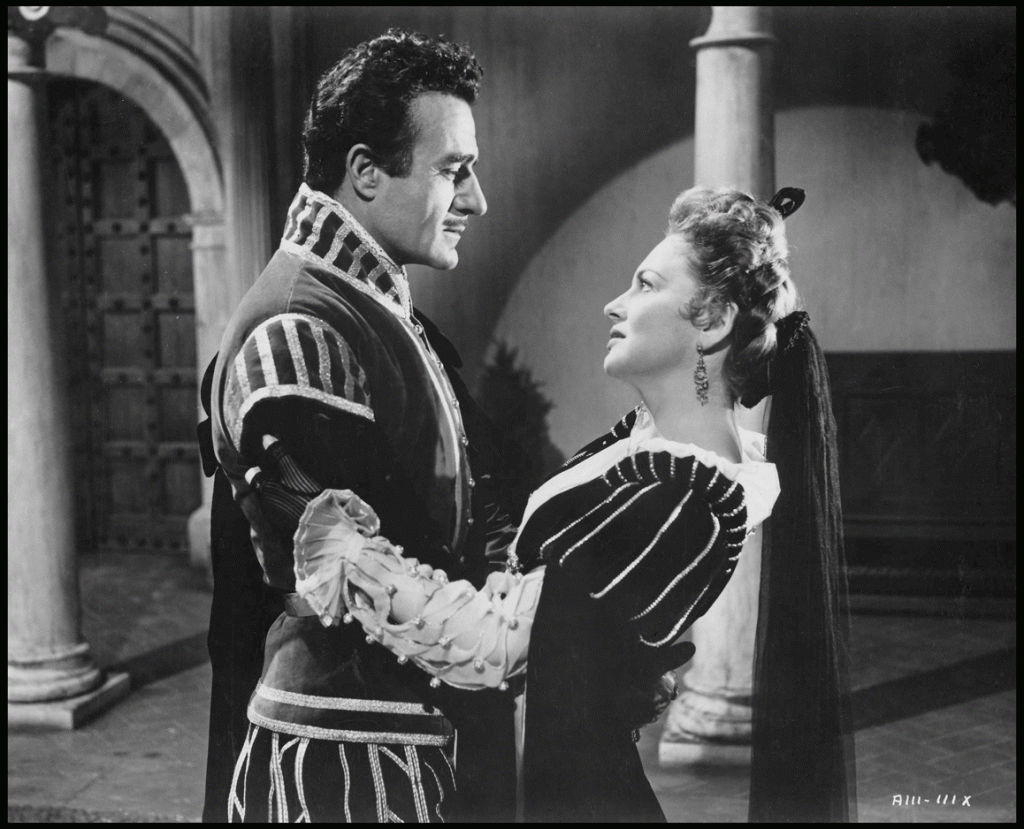
A good way to conclude this blog is with an Olivia de Havilland film that I have not yet seen. It costars Gilbert Roland (pictured with Olivia), and Paul Scofield as King Phillip II of Spain. The film is That Lady (20th Century Fox, 1955) and it has an interesting plot summary that sounds as if it includes swordplay, unconsummated love, jealousy, and might end in tragedy. (Louis Kraft personal collection)

